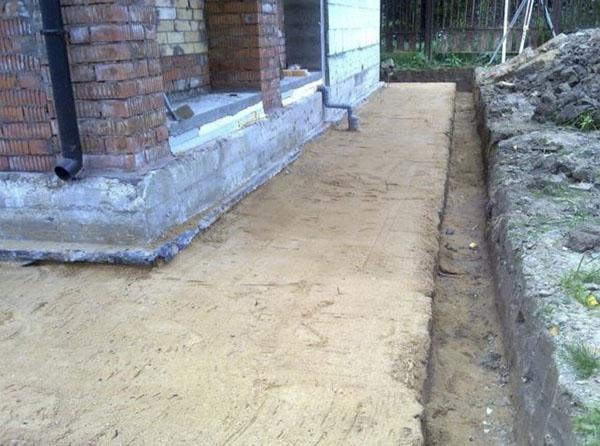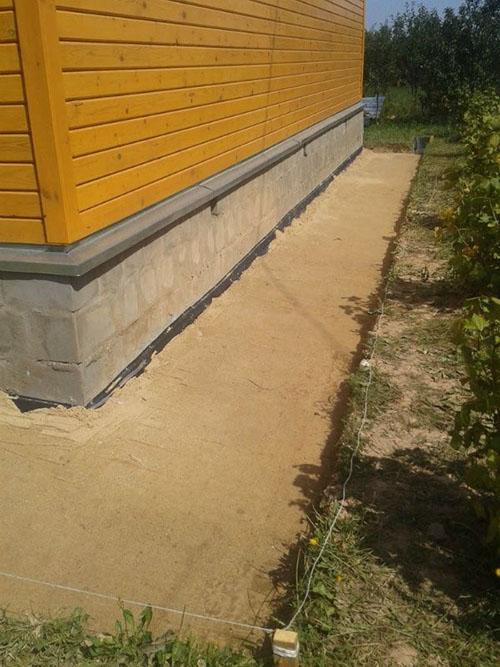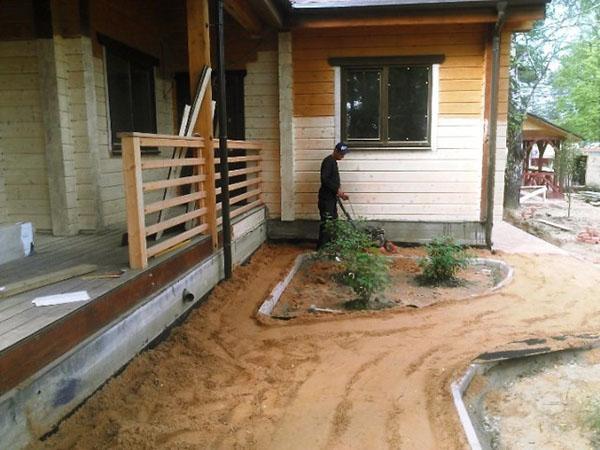Clay blind area around the house: installation rules
 Clay blind area around the house is one of the first options for the protective layer, which began to be practiced many years ago. This simple waterproofing and insulating device reliably protects the foundation of any structure from rain. You don't need to have special skills to do it. And it will take very little time. How to properly make a blind area at the foundation, you can learn from this article.
Clay blind area around the house is one of the first options for the protective layer, which began to be practiced many years ago. This simple waterproofing and insulating device reliably protects the foundation of any structure from rain. You don't need to have special skills to do it. And it will take very little time. How to properly make a blind area at the foundation, you can learn from this article.
Clay blind area around the house: main functions

It has been repeatedly tested in practice that it is the clay layer that protects the foundation 100% from rain and groundwater.
The blind area performs such significant functions:
- Resists the forces of heaving in the soil, which are provoked by frozen water seeping into the base of the foundation. If these forces are not "extinguished", do not distribute them evenly along the entire perimeter of the foundation, then the house will crack over time and collapse.
- Reduces the influence of rainwater and melted snow that flows down and falls on the side surfaces of the foundation. Without such protection, the structure will also begin to collapse. For each square meter of walls, the load can be 5-7 tons.
- Leads to a decrease in the moisture content in the land adjacent to building foundation... If you do not make high-quality waterproofing of the foundation, then with high soil moisture, water will enter and accumulate in the basement spaces.
- Is pedestrian track (on the sidewalk), because on the clay pavement you can easily walk around the whole house.
- It is a decorative element of the house itself and the site.
Compared to other types of blind area, clay construction has a number of advantages. The main "plus" of this design is that it easily tolerates significant temperature changes. She is not afraid of soil displacement due to seasonal phenomena, garden and horticultural work. All this is achieved due to the amortization and flexibility of the clay layer. Also, the blind area takes a "blow" on itself when the soil freezes. Dense and hard coatings for such a "game" are unable to fully protect the foundation, they are motionless and give cracks.
Clay is a versatile material that a person can handle even without building skills. Therefore, to equip such a stage, there is no need to call the construction team and spend money to pay for the work. To make a clay blind area around the house with your own hands, it is important to adhere to the basic rules.
Laying a clay blind area with your own hands
 The most optimal and economical option is to make a clay blind area yourself. It is very easy to install and does not require any repairs as such. Houses with such protective layers, built many years ago, stand without cracks, do not collapse. This is the best confirmation of the reliability and effectiveness of the clay blind area.
The most optimal and economical option is to make a clay blind area yourself. It is very easy to install and does not require any repairs as such. Houses with such protective layers, built many years ago, stand without cracks, do not collapse. This is the best confirmation of the reliability and effectiveness of the clay blind area.
 The construction of a blind area around the house must begin with an inspection of the soil. There must be a drainage component under the layer of grass. Then you should dig a trench, pour a cushion of gravel and sand, otherwise the water will not leave the foundation. The depth of the trench is about 30 cm, its width is about 80 cm.
The construction of a blind area around the house must begin with an inspection of the soil. There must be a drainage component under the layer of grass. Then you should dig a trench, pour a cushion of gravel and sand, otherwise the water will not leave the foundation. The depth of the trench is about 30 cm, its width is about 80 cm.
If you make a blind area with a smaller width, then it will only be a decorative, and not a protective element of the structure.
If no gravel was found, then it can be replaced with other materials that can provide good drainage... After laying, the layer must be carefully tamped. Place a waterproofing material between the walls of the house, the foundation and the clay ball. In this case, the blind area will always remain dry and will last a very long time.
 A small ball of sand and 10-15 cm of clay should be poured over a tamped pillow 10 cm thick. Stones should be tamped into the sand to make the layer more durable. With sufficient foundation height, the amount of clay can be increased. From above it is strengthened and at the same time decorated with large rubble, stones, pebbles. This coating will prevent rock particles from being washed away.
A small ball of sand and 10-15 cm of clay should be poured over a tamped pillow 10 cm thick. Stones should be tamped into the sand to make the layer more durable. With sufficient foundation height, the amount of clay can be increased. From above it is strengthened and at the same time decorated with large rubble, stones, pebbles. This coating will prevent rock particles from being washed away.
The slope of the blind area
 This is a very important point when laying the blind area, it ensures the correct functioning of the protective layer. If the angle of inclination is made too small, then the water will leave slowly, which will lead to the destruction of the foundation.
This is a very important point when laying the blind area, it ensures the correct functioning of the protective layer. If the angle of inclination is made too small, then the water will leave slowly, which will lead to the destruction of the foundation.
The width of the blind area depends on the type of soil in a particular area, as well as on the length of the cornice edge.
You can achieve the desired result using the following methods:
- Create the required slope from the very start of the cover.
- Ensure the slope of the clay coating due to the difference in the height of the layer near the wall of the house (here it is always higher) and at the outer edge of the blind area (here from below).
The recommended transverse angle of inclination of the protective layer is 1.5-2% of its width. In other words, 1.5-2 cm for every meter of width.
Insulation of the blind area made of clay
 When constructing a blind area around the house, which is heated, it is necessary to take care of its insulation. If a building for technical purposes or a house is intended for living only in the warm season, there is no point in insulating a clay ball.
When constructing a blind area around the house, which is heated, it is necessary to take care of its insulation. If a building for technical purposes or a house is intended for living only in the warm season, there is no point in insulating a clay ball.
A layer of insulation during the construction of a blind area has a number of advantages:
- eliminates soil freezing, reduces its swelling in winter;
- allows you to save on heating the house;
- reduces the height of the foundation and the cost of its construction, provided that the blind area was thought out from the very beginning of construction and was taken into account when calculating the depth of laying the foundation;
- protects the finishing layer of the basement.
For insulation of clay blind areas, materials such as polyurethane foam or expanded polystyrene obtained by extrusion are most often used. With fine-grained soils, the layer of insulation is about 5 cm. More accurate calculations of thermal insulation are carried out taking into account the climate of a particular region.
As you can see from the article, making a blind area is not so difficult. In order for it to reliably protect the house from moisture, it is enough to adhere to simple rules.